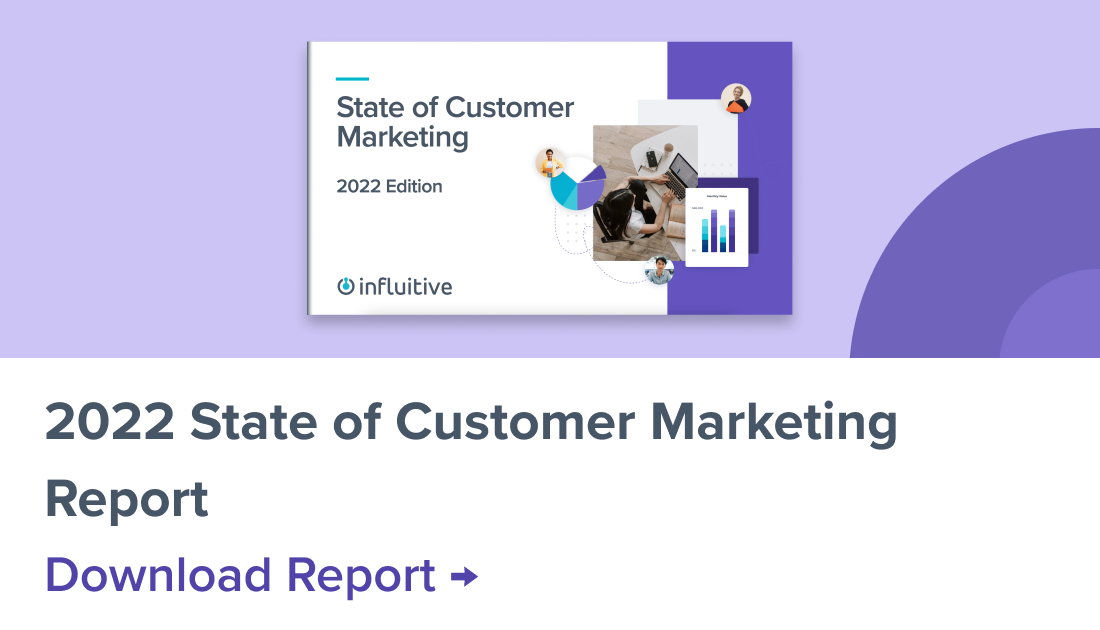Quick: what’s the first thing that comes to mind when you hear the phrase “customer marketing”?
According to Bo Bandy, former Director of Marketing at ReadyTalk and current Director of Strategic Marketing at Gogo Business Aviation, for many companies, the unfortunate answer is “references”.
While she agrees that reference programs are an important component of customer marketing, Bo believes that companies who aren’t willing to look beyond the reference horizon are missing out on the full range of value that comes with customer marketing.
“There’s so much more opportunity for a customer marketer to engage with customers and build a very strong advocacy program,” she says.
Which customer marketing metrics to track
According to the 2017 State of Customer Marketing report, customer reference programs aren’t the only customer marketing effort companies are engaging in. Other programs include:
- customer user groups and events
- communities
- cross-sell and upsell programs
- customer referral programs
- customer advocacy programs
- renewal campaigns
While customer references and testimonials remain the most widely used customer marketing activity, the study shows that companies engaging in other customer marketing efforts–namely customer referral programs, customer satisfaction programs, and renewal campaigns–are seeing a higher impact on revenue and are happier with the impact of their customer marketing programs.
The importance of strategy in customer marketing
For Bo, successful customer marketing begins with strategy. She emphasizes that companies should approach customer marketing in the same strategic manner as they do demand generation, and that both should have an equal seat at the marketing table.
“There is a case to be made that customer marketing is just as important as demand gen, if not more,” says Bo. “Once you have a customer, it’s easier and cheaper to keep them than to acquire new ones.”
This is corroborated by the 2017 State of Customer Marketing report, in which 49% of respondents reported that their customer marketing efforts resulted in moderate or significant revenue.
To be successful, customer marketing can’t exist in a vacuum. “We make sure the voice of the customer is involved in a lot of things,” she says, from webinars to onboarding support to product feedback. By keeping customers integrated into every facet of her strategy, she can get buy-in from teams across her organization.
Bo adds that, with this strategic role, comes the responsibility of showing a return on customer marketing efforts. “You shouldn’t spend money on what you can’t measure.”
Measuring success in more ways than reference counts
Because customer marketing had such a positive impact on a variety of both tactical and strategic measures at ReadyTalk throughout her time there, Bo admits that she is frustrated when people want to measure success solely by the number of references gained.
“It’s not just about the marketing funnel anymore. It’s really about the customer funnel,” she says. She tries to focus on metrics such as NPS scores and other measures of customer engagement as well, rather than focusing only on leads and revenue.
To provide a view of the customer experience at all touchpoints, ReadyTalk also made use of metrics from customer events. This included the number of people who attended and the effects of their attendance on product usage and churn.
“We weren’t doing it perfectly,” says Bo. “It’s a very sticky science experiment that we were just playing with.”
Changing perceptions around customer marketing
Bo believes that, in order for people begin thinking about customer marketing as a strategic player, companies must first properly define the role. She notes that she’s seen “too many” job listings for customer marketers that focus on reference programs, and not on the strategic nature of the role.
According to Bo, in a perfect world, job descriptions for customer marketers would include the following:
- Ability to strategically and thoughtfully develop customer campaigns that have an impact on recurring revenue or other meaningful measurements
- Capability to build programs that include a variety of customer marketing tactics, including case studies, references and referrals
- Ability to work closely with other teams, including customer success or account management teams
- Talent for connecting with customers and creating strong relationships that lead to advocacy
Bo also notes that this shift in thinking will take some education. She advises talking to marketing peers to help them understand what a customer marketer can bring to the team.
“It’s a cultural shift for companies,” she concluded. “They have to value their customers and see the value that growing those relationships can bring.”
Further reading on the strategic importance of customer marketing programs:
- The top dashboards customer marketers use to track ROI
- How Iron Mountain saw six-figure revenue growth as a result of their customer marketing program
This blog was originally published on November 7th, 2014 and updated on February 15th, 2017.










































